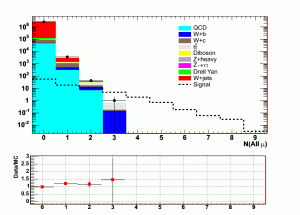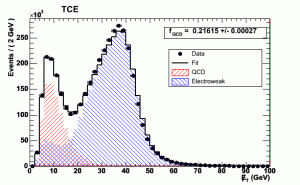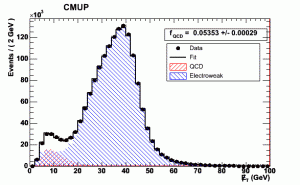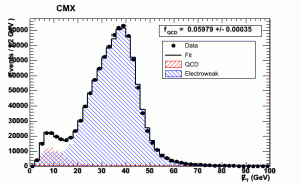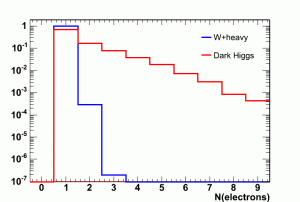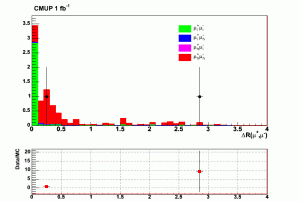Using the results of the (pTrel,d0Significance) fit below, we obtain the background prediction for the 3.6 fb-1 sample. They are:
TCE mu+ mu+:
#mu^{+}_{l}#mu^{+}_{l}=0.443923
#mu^{+}_{l}#mu^{+}_{h}=2.1214
#mu^{+}_{h}#mu^{+}_{h}=8.60857
nbg=11.1739
data=9
TCE mu+ mu-:
#mu^{+}_{l}#mu^{-}_{l}=3.10351
#mu^{+}_{l}#mu^{-}_{h}=2.01054
#mu^{+}_{h}#mu^{-}_{l}=2.4465
#mu^{+}_{h}#mu^{-}_{h}=36.4959
nbg=44.0564
data=15
TCE mu- mu-:
#mu^{-}_{l}#mu^{-}_{l}=0.971373
#mu^{-}_{l}#mu^{-}_{h}=1.69165
#mu^{-}_{h}#mu^{-}_{h}=8.66579
nbg=11.3288
data=8
CMUP mu+ mu+:
#mu^{+}_{l}#mu^{+}_{l}=0.403686
#mu^{+}_{l}#mu^{+}_{h}=0.972838
#mu^{+}_{h}#mu^{+}_{h}=5.16716
nbg=6.54368
data=5
CMUP mu+ mu-:
#mu^{+}_{l}#mu^{-}_{l}=1.87454
#mu^{+}_{l}#mu^{-}_{h}=1.10496
#mu^{+}_{h}#mu^{-}_{l}=1.34186
#mu^{+}_{h}#mu^{-}_{h}=19.3975
nbg=23.7189
data=5
CMUP mu- mu-:
#mu^{-}_{l}#mu^{-}_{l}=0.603845
#mu^{-}_{l}#mu^{-}_{h}=1.08485
#mu^{-}_{h}#mu^{-}_{h}=4.82156
nbg=6.51025
data=2
CMX mu+ mu+:
#mu^{+}_{l}#mu^{+}_{l}=0.169583
#mu^{+}_{l}#mu^{+}_{h}=0.564945
#mu^{+}_{h}#mu^{+}_{h}=3.43739
nbg=4.17192
data=0
CMX mu+ mu-:
#mu^{+}_{l}#mu^{-}_{l}=1.22732
#mu^{+}_{l}#mu^{-}_{h}=0.816829
#mu^{+}_{h}#mu^{-}_{l}=0.768016
#mu^{+}_{h}#mu^{-}_{h}=11.7364
nbg=14.5486
data=3
CMX mu- mu-:
#mu^{-}_{l}#mu^{-}_{l}=0.305322
#mu^{-}_{l}#mu^{-}_{h}=0.460449
#mu^{-}_{h}#mu^{-}_{h}=3.38036
nbg=4.14613
data=2
The background prediction is generally higher and is much higher for the opposite sign final states.
Ratio tables used to get the prediction and some representative kinematic plots after the break.
Continue reading Dimuon predicted and observed for 3.6 fb-1 →
